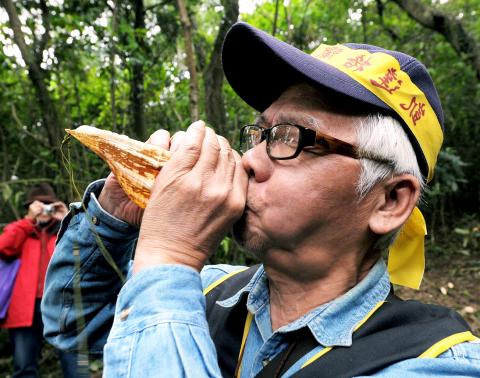|
Ketagalan
descendants’ rite honors ancestors
UNUSUAL LOCATION: The ritual was conducted in
front of a tomb on Fanzai Hill, which is now part of the Fourth Nuclear Power
Plant compound in New Taipei City
By Loa Iok-sin / Staff reporter

Lin Sheng-yi, director of the
Center for Ketagalan Culture and History, blows into a conch shell to summon
ancestral spirits at a ceremony inside the Fourth Nuclear Power Plant compound
in New Taipei City yesterday.
Photo: CNA
Descendants of the Ketagalan Aborigines
performed a ritual paying homage to their ancestral spirits yesterday at the
Fourth Nuclear Power Plant, asking the ancestral spirits for help in their
struggle for official recognition and to drive away the devils — including the
nuclear power plant.
The ceremony was conducted in front of a tomb believed to be the burial site of
a Ketagalan tribal member that now lies within the plant compound in Gongliao
District (貢寮), New Taipei City (新北市).
Covering the ground and a small stone table with large shell ginger leaves in
front of a tomb on Fanzai Hill (番仔山, “Savages’ Hill”), some Ketagalan
descendants quickly placed offerings on the leaves, while others helped to clear
weeds and cut down small trees around the tomb.
Lin Sheng-yi (林勝義), director of the Center for Ketagalan Culture and History and
a Gongliao native whose mother is a Ketagalan Aborigine and whose father is Han
Chinese, began the ceremony by spreading rice wine with a branch around the tomb
to cleanse the area, then blowing a conch horn to summon ancestral spirits.
Lin recited an oration for ancestral spirits and burned papers with the oration
written on it afterwards. He ended the ritual by spreading sesame seeds around
the tomb.
“Offerings include betel nuts, seashells and mountain olives,” Lin said.
“Seashells were used as a medium of exchange when ancient Ketagalans traded with
other tribes, so they are offered to express our appreciation for our ancestors’
creation of our civilization, while mountain olives were an important food for
us, and they are offered to thank our ancestors for bringing us food,” he said.
Lin said the Ketagalans believe that one sesame seed could turn into 3,000
warriors, so he spread sesame seeds in the hope that warriors would help to
protect the tomb.
“In the oration, I expressed my gratitude for our ancestors, and asked for a
hand from our ancestral spirits in our struggle for official recognition and to
drive away all evil spirits that are in our territories,” Lin said after the
ceremony. “Evil spirits refer to everything that would damage the ecosystem and
culture within the Ketagalan territories.”
When asked if that includes the nuclear power plant, Lin nodded yes.
“The construction of the nuclear power plant has damaged many Ketagalan relics,”
he said.
Pan Jee-yang (潘紀揚), chairman of the Taiwan Association for Rights Advancements
for Pingpu Plains Aborigines, said that most of what is now Taipei and New Tapei
City was the traditional territory of the Ketagalan tribe before the arrival of
Han immigrants hundreds of years ago.
“The Fourth Nuclear Power Plant now stands on what used to be a Ketagalan
village. That is why the hill got the name Fanzai Hill, since Han people used to
call Aborigines ‘fan’ (番, savage),” he said. “It is very important to remember
our history, especially at a time now when the government refuses to grant
official recognition to Pingpu Aborigines.”
|
![]()
![]()
![]()